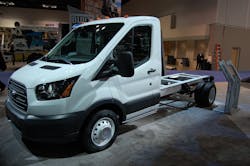INDIANAPOLIS. Ford Motor Co. believes U.S. market conditions are starting to come together in a way that should help boost sales of truck and vans in the coming years; a critical driver behind the OEMs ongoing efforts to revamp its products in both those categories, said Len Deluca, the company’s director of commercial vehicle sales and marketing.
“Not only are business conditions getting better but we’re also continuing to bring new products to market,” he explained during a press conference here at the National Truck Equipment Assn.’s 2013 Work Truck Show.
“A lot of good things are going on,” he noted. “Housing starts are up, and when housing starts go up, sales of pickup trucks go up. Also, the average age for cars and light trucks is way up – 11.3 years for cars and 11.1 years for light trucks – and that’s a good indicator for replacement demand.”
[To watch a video of Deluca’s presentation, please click here.]
Deluca added that light vehicle sales have seen slow to moderate growth since the depths of the recession in 2009 and that Ford is forecasting total light vehicle sales to reach 15 million to 17 million units in the 2014-2017 timeframe.
[To view some of the vehicles and engines Ford displayed at the Work Truck Show, click here.]
“That’s when we’re getting back to those healthy pre-2008 volumes,” he added. “And that’s why over the next three to four years we plan to further enhance our product line with new models or significant enhancements to current product.”
Ford believes one the keys to driving that sales growth will be the van segment, which is why the OEM is replacing its E-Series full-size van line with its new Transit model by next year while it also completely redesigned its Transit Connect small cargo van for the 2014 model year.
“When we introduced the Transit Connect in North America back in 2010, it was already seven years old,” Tim Stoehr, Ford’s commercial truck marketing manager, told Fleet Owner. “The reason small vans like this are resonating so well is not only are North American cities becoming denser like in Europe but fuel costs keep rising – and every time they do, businesses re-evaluate their vehicle purchase strategies.”
The redesigned 2014 Transit Connect is one of 10 models based on Ford’s “C-1” global platform and will be offered in two wheel base sizes – 105-in. and 212-in. – providing 105 cu. ft. and 130 cu. ft. of cargo storage room, respectively.
The standard engine for the Transit Connect will now be a 2.5L iVCT gasoline model that can be converted to run on CNG or propane, with a 1.6L EcoBoost I4 gasoline engine as an option. The van also gets a 6-speed automatic versus the 4-speed in previous iterations.
Chris Brewer, global chief nameplate engineer for Ford’s Transit program, pointed out that the new full-size Transit van is designed with what he termed “maximum flexibility” so it can appeal to a wider range of customers.
“The key is to offer the customer multiple options so the vehicle best fits their business,” he told Fleet Owner. “They’ve got three body lengths and three roof heights to choose from; three engine options; a cutaway chassis option; single and dual rear wheel options. Simply put, this Transit represents the equivalent of three new vehicle lines all rolled into one.”
[To watch a video of Brewer describing some of the Transit features in more detail, click here.]
Brewer added that in Europe, vans are like pickups to the U.S. – “they are everyone in all shapes and sizes” – so Ford needed to design a platform that would meet the needs of van owners on both sides of the Atlantic.
“Simply put, this is a critical tool for a wide assortment of customers to move cargo and people,” he said. “So we needed to build far more flexibility into this vehicle – especially in terms of the body – than we’ve done in the past. We believe this is the biggest product change this segment has seen in some time.”
Follow Sean Kilcarr on twitter @trucksatwork
About the Author
Sean Kilcarr
Editor in Chief
Sean Kilcarr is a former longtime FleetOwner senior editor who wrote for the publication from 2000 to 2018. He served as editor-in-chief from 2017 to 2018.
